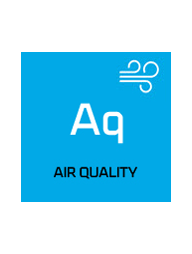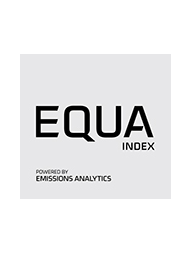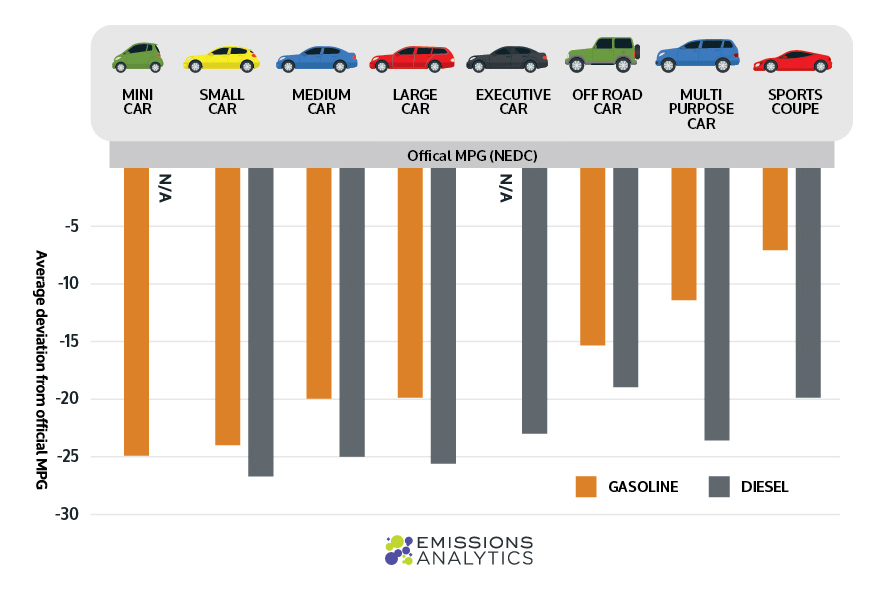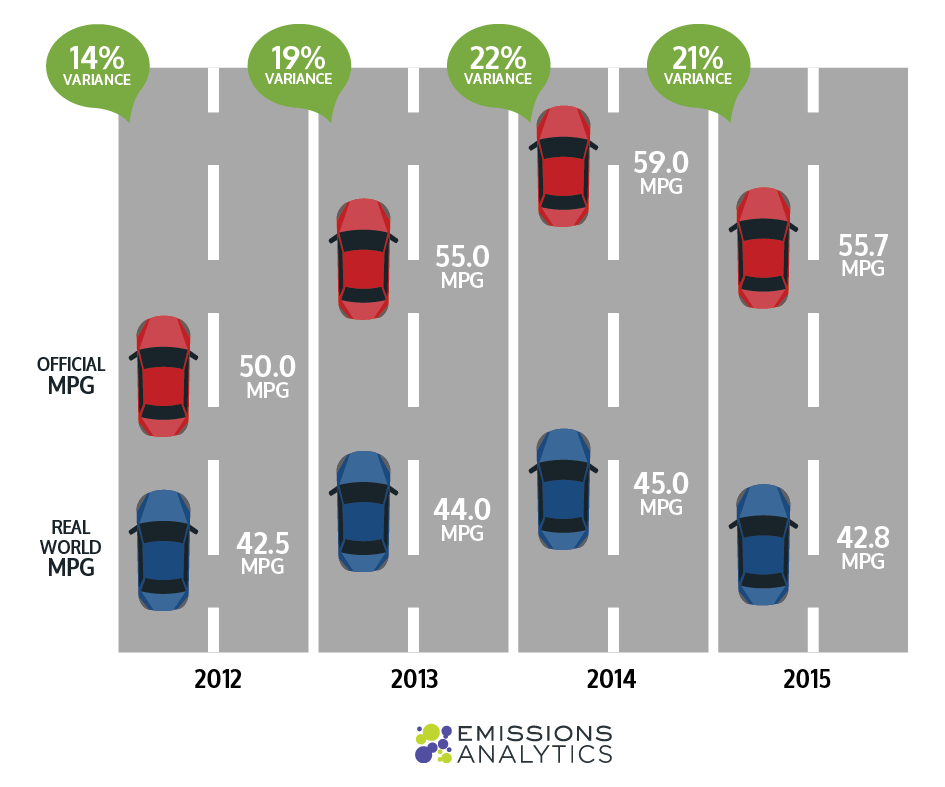New testing cycle brings CO2 taxation uncertainty
Industy experts have raised the prospect of fleets paying higher emissions-based tax bills following the introduction of the Worldwide Harmonized Light Vehicles Test Procedure (WLTP), which will replace the existing New European Driving Cycle (NEDC) test in September 2017 and is expected to inflate official vehicle CO2 figures due to its stricter rules.
Industy experts have raised the prospect of fleets paying higher emissions-based tax bills following the introduction of the Worldwide Harmonized Light Vehicles Test Procedure (WLTP), which will replace the existing New European Driving Cycle (NEDC) test in September 2017 and is expected to inflate official vehicle CO2 figures due to its stricter rules.
Business Car, 30 November 2016
Emissions Analytics says average diesel emissions are still significantly reduced
Vehicle testing firm Emissions Analytics says diesels can be clean and govenments are highly unlikely to give up the fuel just yet.
Fleet News 16 November 2016
Are diesels done for?
As the government loses a second high court ruling brought by ClientEarth, many are now sounding the death knell for diesel cars. Not so fast, says Emissions Analytics, diesels can be clean and govenments are highly unlikely to give up the greenhouse gas advantage of diesel in the short- or medium-term.
As the government loses a second high court ruling brought by ClientEarth, many are now sounding the death knell for diesel cars. Not so fast, says Emissions Analytics, diesels can be clean and govenments are highly unlikely to give up the greenhouse gas advantage of diesel in the short- or medium-term.
Since the introduction of Euro 6 in September 2014, manufacturers have been forced to improve their after-treatment systems to meet the stricter legislated limits for NOx. Exhaust Gas Recirculation, Lean NOx Traps, and Selective Catalytic Reduction technologies have been employed as part of a complex strategy to reduce tailpipe emissions. There have been variable successes, with some achieving the regulated limits even in real-world driving and the worst more than 20 times the legal limit. Overall, average NOx emissions from Euro 6 diesels are down 55% compared to Euro 5s.
Nonetheless, there is still the fact that many new cars do not meet the legislated limits in real-world operation. Our data shows NOx emissions are on average 4.3 times over the limit for Euro 6 cars and, after a period of improvement, this Conformity Factor is rising. This is the heart of the issue, as to whether diesels are the major and unavoidable cause of poor air quality in towns and cities.
Consequently, there have been many suggestions made to combat the problem of dirty diesels. These range from the London Mayor’s T-charge, to a diesel scrappage scheme, to a total ban on diesel vehicles in certain zones. However, Emissions Analytics’ data shows that modern diesels in their own right can be clean.
Since the launch of the EQUA Air Quality Index six months ago, twelve cars have how achieved an A-rating including the latest Volkswagen Tiguan, meaning it has met the 0.08g/km limit in real-world driving.
This proves that diesels can be clean and the reason most are not is down to a failure of regulation and enforcement and not the technical impossibility.
There is also the issue of CO2 emissions to be considered. Despite Donald Trump tweeting that climate change was, “created by and for the Chinese in order to make U.S. manufacturing non-competitive,” the British government has an empirical view on global warming and stands by its commitment to cutting its carbon footprint. Would ministers give away the 16% CO2 advantage – according to Emissions Analytics’ testing – diesel has over gasoline for the same distance driven in real-world operation, until there is a viable alternative.
In the future electric and hybrid vehicles may deliver the CO2 advantage required, as well as greatly reducing, or eliminating, NOx and other harmful emissions, at which point diesel powered engines for passenger cars may come to the end of the road. However, with a share of the market of less than 2%, there is still a way to go for these vehicles. Until then, Emissions Analytics’ data strongly suggests the policy focus should be on sorting the clean from the dirty diesels and incentivising manufacturers to bring forward clean technology.
The latest EQUA Aq Index results are available online
Emissions Analytics’ new EQUA Carbon Dioxide Index reveals car manufacturers miss target by 39%
Emissions Analytics’ new EQUA Carbon Dioxide Index reveals car manufacturers miss target by 39%
EQUA Mpg Index – a media round up
Find here how the press have been reporting the latest EQUA Index powered by Emissions Analytics
To find out how the press have been reporting the latest EQUA Index powered by Emissions Analytics click on the links below.
VW Tiguan makes the grade in EQUA Air Quality Index while others flounder
This month’s additions to the EQUA Quality Index show that some vehicle mensurates continue to successfully tackle the issue of harmful NOx Emissions
VW dieselgate: Is it even about the environment
Volkswagen might have agreed to one of the largest ever corporate settlements to tackle the emissions scandal, but industry insiders are now questioning whether that’s enough.
Volkswagen might have agreed to one of the largest ever corporate settlements to tackle the emissions scandal, but industry insiders are now questioning whether that’s enough.
Emissions Analytics launches EQUA Carbon Monoxide Index
Emissions Analytics is pleased to announce the launch of the EQUA CO Index. The second in the EQUA Index series, EQUA CO looks at whether carbon monoxide regulations are being achieved in real-world operation.
Emissions Analytics is pleased to announce the launch of the EQUA CO Index. The second in the EQUA Index series, EQUA CO looks at whether carbon monoxide regulations are being achieved in real-world operation.
Potentially fatal for humans as well as damaging to the environment, carbon monoxide is generally considered a problem primarily confined to gasoline vehicles. Regulations distinguish between the fuel types, with diesels having a more stringent but, due to their technology, easier to achieve limit of 0.5g/km. Gasoline vehicles have to meet a more generous 1.0g/km limit which is typically achieved using a three-way catalyst. Therefore, the regulations are not technology neutral and allow gasoline vehicles to emit twice that of diesels and still be compliant.
In the same way that Emissions Analytics rates emissions of NOx from diesels, gasolines and hybrids with a single scale on the EQUA Aq Index, the EQUA CO Index awards a universal rating regardless of fuel type. Thus despite the regulations setting different boundaries, the EQUA CO Index allows comparisons between vehicles. The A++ to H ratings are set as follows:
Using these classes, a diesel car awarded an A to A++ meets the regulated level even in real-world driving, whereas a gasoline vehicle with a C to A++ meets the regulated levels for this fuel.
Of the 734 vehicles currently on the EQUA CO Index, 96% emit the regulated amount of CO or less. However, there are some interesting exceptions. Several Mercedes C-Class diesels are over 0.5g/km, out of a small number over the limit. Additionally, 8% of gasoline vehicles, that is 24 models tested by Emissions Analytics, do not meet the regulated limit, with one outlier being more than six times over. If the regulations were to change and gasolines had to achieve the same, stricter standard as diesels, the number of cars failing to reach this standard would increase to 20%. Of the hybrid vehicles tested, all achieve the regulated limit apart from the Mitsubishi Outlander which scored a D-rating when not running on its electric engine.
The vehicles tested by Emissions Analytics are all run on our standard real-world cycle. The tests are conducted by a small pool of highly trained technicians and the vehicle and testing equipment is carefully prepared to make sure it is fully warmed up and in the manufacturers’ default settings.
The data shows that illegal levels of carbon monoxide are not as prevalent in real-world driving as excess NOx from diesels. However, given the toxicity of CO, this is a situation that needs to be monitored. This could become particularly relevant if there is a market shift away from diesel towards gasoline as a result of dieselgate and other emerging regulations and taxes. Emissions Analytics will continue to keep a watchful eye on on-road vehicle performance, checking it against official certification and publishing the results online on the Carbon Monoxide page at the EQUA Index site.
Subscriptions are available to the Emissions Analytics database. Contact us for details.
Downsized and supersized engines hit A grade in EQUA Air Quality Index
Downsized and supersized engines hit A grade in EQUA Air Quality Index
A visualisation of cars tested for the EQUA Aq Index
A visualisation of cars tested for the EQUA Aq Index, split by Euro standard and fuel type, showing progress towards reduction of NOx emissions
A visualisation of cars tested for the EQUA Aq Index, split by Euro standard and fuel type, showing progress towards reduction of NOx emissions.
Emissions Analytics delivers big data to ENTRIS in definitive HGV emissions tests
Emissions Analytics delivers big data to ENTRIS in definitive HGC emissions tests
New EQUA Index reveals true pollutant emissions for car buyers
With Mitsubishi Motors the latest manufacturer to admit to impropriety in its testing procedures, the need for impartial real-world data has never been greater.
With Mitsubishi Motors the latest manufacturer to admit to impropriety in its testing procedures, the need for impartial real-world data has never been greater. Today Emissions Analytics is launching the new EQUA Index rating scheme to help bring transparency in the first instance to the issue of air quality.
The EQUA Air Quality Index is based on the level of emissions of nitrogen oxides (NOx) in grams per kilometre emitted during our real-world tests. The Index aligns the boundaries between ratings values as much as possible with recognisable points. See below:
The EQUA Air Quality Index is intended to complement the forthcoming regulations for new vehicle certification, by monitoring vehicle performance when driven normally on roads; in effect keeping a watchful eye on the effectiveness of the new regulations.The problems with the existing test system, the NEDC, which have been the cause of so many of the issues covered by the media recently, are already being addressed by regulators in Europe. From 2017 the World Harmonised Light Duty Test Protocol (WLTP) will change the way CO2 is measured and Real Driving Emissions will address problems with NOx measurement.
The other great benefit of the EQUA Air Quality Index is to help car buyers. Designed to be clear and concise, the simple A to H rating allows manufacturers and retailers to show how different models compare in the showroom, whether diesel, petrol or hybrid. It is also ideal for car reviewers and publishers to include as new cars are reviewed. And because the scheme is independently financed and researched, consumers, companies and the wider automotive industry can have confidence in the impartiality of the data.
The EQUA Air Quality Index has been developed by Emissions Analytics in conjunction with a group of experts to guide, review the test and rating methodology, monitor the regulatory context, and provide input into the wider development of the index. The group includes:
Professor Helen ApSimon – Air Pollution Studies, Imperial College London, UK
Dr Adam Boies – Department of Engineering, The University of Cambridge, UK
John German – Senior Fellow, The International Council on Clean Transportation, USA
Dr Marc Stettler – Centre for Transport Studies, Imperial College London, UK
Professor Martin Williams – Air Quality Scientist, King’s College London, UK
There are almost 450 vehicles on the EQUA Air Quality Index now, so why not have a look?
Snapshot #9: Class matters when it comes to MPG
We looked at our data on over 750 EU cars tested, to see how much of an influence vehicle class was on variance between the NEDC-derived official MPG and our cycle
We looked at our data on over 750 EU cars tested, to see how much of an influence vehicle class was on variance between the NEDC-derived official MPG and our cycle and found:
Petrol sports cars come closest to their official figures
The MPG gap is worse for small cars, whatever the fuel
Overall the gap is almost always bigger for diesel engines.
Do a PhD with King’s College London and Emissions Analytics
Characterising non-road mobile machinery emissions through portable emissions testing and emissions inventory development
Characterising non-road mobile machinery emissions through portable emissions testing and emissions inventory development
An exciting opportunity exists to investigate the emissions from vehicles and generators on construction sites working with academic, industry and government partners to deliver a scientifically ground breaking and policy relevant PhD. Current emissions inventories estimate that Non-Road Mobile Machinery (NRMM) contributes approximately 10% of the NOX and PM10 emissions within London. However, there is a large uncertainty in this estimate as very few real-world emission measurements have been made of these sources, instead relying on engine test beds and activity estimates have been based on simplified assessments of construction activity. This project aims to address both of these aspects by undertaking state-of-the-art Portable Emissions Measurement System (PEMS) tests on NRMM machinery and utilising the latest information available through London’s NRMM register to assess the fleet activity. An opportunity also exists to test innovative emissions abatement solutions to provide policy-relevant scenario testing for emissions abatement.
For full details about the project, please visit http://www.kcl.ac.uk/health/study/studentships/div-studentships/aes/green.aspx
Has fuel economy started to fall?
Average fuel economy has fallen for the first time since Emissions Analytics began its real-world test programme in 2011.
Average fuel economy has fallen for the first time since Emissions Analytics began its real-world test programme in 2011. Not only that but the ‘gap’ between official figures and our results did not widen last year. The reason for this appears to be intrinsically linked to the introduction of the Euro 6 emissions standards. This newsletter looks to explain what our data is showing and what this means for fuel economy and CO2 targets in the future.
Evident in our recently published infographic, pictured above, fuel economy has dropped by 3.3 mpg in 2015 and the ‘gap’ has shrunk slightly from 21.5% in 2014 to 21.3% in 2015.
The explanation for this change is due to two main factors, around the mix of vehicles tested and the typical performance of the latest diesel engines. As Emissions Analytics tests vehicles around the time they are launched, there is inevitable fluctuation in the types tested, and hence the mix. This was made more notable with the introduction of the Euro 6 emissions regulations for all new vehicles sold from September 2015.
In the run-up to this deadline, the last of the Euro 5 vehicles had a strong bias towards larger, more powerful vehicles, with lower fuel economy. Perhaps manufacturers were concentrating on releasing the Euro 6 versions of their high volume models first, leaving compliance for the lower-selling or harder-to-comply models until the end of the Euro 5 window.
At the same time as this mix effect, 2015 also saw a reduction in the average fuel economy of the Euro 6 diesel cars tested. These were on average 5.4% less fuel efficient than the Euro 6 diesels tested in 2014. This is likely to be due to some combination of the mix of makes and models launched and in many cases the additional fuel requirement of the NOx abatement systems. In contrast, Euro 6 petrol vehicles tested in 2015 saw a 5.8% improvement in fuel economy compared to those tested in 2014 – these vehicles did not have extra NOx after-treatment systems.
This led us to look at whether the conformity factor (ratio of emissions in real-world driving to the regulated emissions level) for Euro 6 NOx was improving over time and what we found was:
Year Conformity Factor
2013 6.7
2014 2.7
2015 3.5
In 2013 we tested just five Euro 6 models, all early adopters of the new technology, which had showed a high average NOx conformity factor, and also a wide spread. In 2014, it appears that well-placed manufacturers brought mainstream Euro 6 models to market with low conformity factors averaging just 2.7. By 1 September 2015, all models had to be Euro 6 compliant, so included model less well optimised after-treatment systems, perhaps driving the average conformity factor back up.
What can also be seen, however, is that the recently upheld Real Driving Emissions NOx Conformity Factor of 2.1 from 2017 is readily achievable for many, with 29% of models already meeting this level in real-world driving, according to Emissions Analytics’ database.
Archive
- AIR Alliance 3
- Air Quality 38
- Audio 3
- Climate Change 14
- EQUA Index 21
- Electrified Vehicles 28
- Euro 7 3
- Fuel Consumption/Economy 20
- Fuels 4
- Infographic 18
- Media 4
- NRMM/Off-road 3
- Newsletter 103
- Podcast 7
- Presentation/Webinar 18
- Press Release 19
- Regulation 16
- Reports 4
- Tailpipe Emissions 49
- Tyre Consortium 2
- Tyre Emissions 26
- Vehicle Interior 6




































